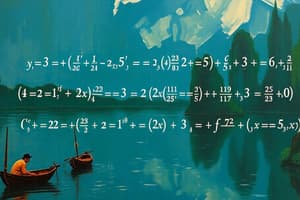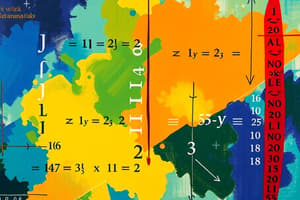Podcast
Questions and Answers
What is the primary goal when solving an equation?
What is the primary goal when solving an equation?
- To simplify the equation
- To change the equation into an inequality
- To eliminate all constants
- To isolate the variable (correct)
What characterizes a quadratic equation?
What characterizes a quadratic equation?
- It always has two solutions
- It represents a linear function
- It is of the form ax² + bx + c = 0 (correct)
- It has only one variable
When graphing a linear equation, what is the slope?
When graphing a linear equation, what is the slope?
- The steepness of the line represented as 'm' in y = mx + b (correct)
- The distance between two points on the x-axis
- The point where the line crosses the y-axis
- The maximum value that y can take
Which of the following is a function?
Which of the following is a function?
What does the degree of a polynomial represent?
What does the degree of a polynomial represent?
In solving systems of equations, what is the elimination method?
In solving systems of equations, what is the elimination method?
Which statement about inequalities is true?
Which statement about inequalities is true?
What is the result of the expression $3x + 2x$?
What is the result of the expression $3x + 2x$?
Flashcards are hidden until you start studying
Study Notes
Algebra
-
Definition: A branch of mathematics dealing with symbols and the rules for manipulating those symbols.
-
Basic Concepts:
- Variables: Symbols (often letters) that represent numbers.
- Constants: Fixed values.
- Expressions: Combinations of variables and constants (e.g., 3x + 2).
- Equations: Mathematical statements asserting two expressions are equal (e.g., 2x + 3 = 7).
-
Operations:
- Addition and Subtraction: Combining or removing values.
- Multiplication and Division: Scaling values or splitting them.
-
Solving Equations:
- Isolate the variable: Use inverse operations to solve for the variable.
- Check your solution: Substitute back into the original equation to verify.
-
Types of Equations:
- Linear Equations: Form y = mx + b; graphs as a straight line.
- Example: 2x + 3 = 7.
- Quadratic Equations: Form ax² + bx + c = 0; graphs as a parabola.
- Example: x² - 5x + 6 = 0.
- Linear Equations: Form y = mx + b; graphs as a straight line.
-
Factoring:
- Process of breaking down equations into simpler components.
- Common methods include grouping, using the distributive property, and applying special products (e.g., difference of squares).
-
Functions:
- Definition: A relation where each input has a unique output.
- Types:
- Linear functions: Represented by linear equations.
- Quadratic functions: Represented by quadratic equations.
- Notation: f(x) denotes a function of x.
-
Systems of Equations:
- Definition: A set of two or more equations with the same variables.
- Methods of solving:
- Graphing: Plotting equations and finding intersections.
- Substitution: Solving one equation for a variable and substituting it into another.
- Elimination: Adding or subtracting equations to eliminate a variable.
-
Inequalities:
- Definition: Mathematical statements indicating one expression is greater or less than another (e.g., x + 3 > 5).
- Graphing: Represented on a number line or coordinate plane with shading to indicate solution sets.
-
Exponents and Radicals:
- Exponents: Indicate repeated multiplication (e.g., x² = x * x).
- Radicals: Involve roots (e.g., √x is the square root of x).
-
Polynomials:
- Expressions that include multiple terms (e.g., 3x² + 2x - 1).
- Degree: Highest exponent in the polynomial.
-
Applications:
- Used in various fields such as engineering, physics, economics, and statistics for modeling real-world scenarios.
Algebra Overview
- Branch of mathematics focused on symbols and rules for manipulating those symbols.
Basic Concepts
- Variables: Symbols representing numbers, commonly denoted by letters.
- Constants: Fixed numerical values.
- Expressions: Combinations of variables and constants (e.g., 3x + 2).
- Equations: Mathematical statements where two expressions are set equal (e.g., 2x + 3 = 7).
Operations
- Addition and Subtraction: Fundamental operations for combining or removing numerical values.
- Multiplication and Division: Operations that scale numbers or divide them into smaller parts.
Solving Equations
- Isolate the Variable: Utilize inverse operations to find the value of the variable.
- Check Your Solution: Verify by substituting the found variable back into the original equation.
Types of Equations
- Linear Equations: Written as y = mx + b; represented graphically as a straight line (e.g., 2x + 3 = 7).
- Quadratic Equations: In the form ax² + bx + c = 0; graphs as a parabola (e.g., x² - 5x + 6 = 0).
Factoring
- Breakdown of complex equations into simpler factors; techniques include grouping, distributive property, and special products like the difference of squares.
Functions
- Definition: A relation between inputs and unique outputs.
- Types:
- Linear Functions: Represented by linear equations.
- Quadratic Functions: Derived from quadratic equations.
- Notation: f(x) signifies a function of a variable x.
Systems of Equations
- Definition: Comprises two or more equations involving the same variables.
- Solving Methods:
- Graphing: Finding solutions by plotting equations and identifying points of intersection.
- Substitution: Isolating a variable in one equation then substituting into another.
- Elimination: Adding or subtracting equations to eliminate a common variable.
Inequalities
- Definition: Expressions indicating the relationship of one value being greater or lesser than another (e.g., x + 3 > 5).
- Graphing: Shown on a number line or coordinate plane, with shading indicating solution sets.
Exponents and Radicals
- Exponents: Indicate repeated multiplication (e.g., x² means x multiplied by itself).
- Radicals: Concern roots of numbers (e.g., √x represents the square root of x).
Polynomials
- Comprised of multiple terms (e.g., 3x² + 2x - 1).
- Degree: The highest exponent in the polynomial.
Applications
- Algebra is applicable in fields like engineering, physics, economics, and statistics, essential for modeling and solving real-world problems.
Studying That Suits You
Use AI to generate personalized quizzes and flashcards to suit your learning preferences.




